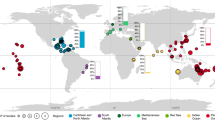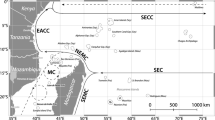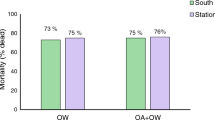Abstract
Climate change-induced ocean warming has reshaped reef ecosystems as coral bleaching events continue to lead to mass coral die-offs globally. These thermal anomalies also negatively affect reef persistence and recovery when heat stress events continue to occur during critical reproduction and recruitment periods. As a result, recruitment (settlement and survival of early life stages) continues to decline on reefs globally, compromising the recovery of reef systems following mass bleaching and mortality events, which has led to the loss of ecological function on these reefs. One mitigation strategy within the active restoration framework includes propagated corals (i.e., adult fragments, larvae, or juveniles) produced in nurseries that are then directly out planted to the reef benthos. Restoration programs can greatly benefit from use of sexually derived coral propagules, which when optimized, increase the scalability and genetic diversity of outplanted stock. Thermal conditioning during larval rearing has the potential to be a cost-effective and scalable strategy to enhance the survival and stress tolerance of subsequent life stages. Here, we tested the potential for thermal conditioning during the larval stage to induce positive latent effects on the stress tolerance of Montipora capitata spat. We exposed larvae to cool (24.5 °C), ambient (27.2 °C), and warm (28.9 °C) conditions for four days and during this period we tracked larval survival. Following thermal conditioning during the larval stage, we measured settlement success and then exposed spat to a 47-day high temperature stress (+ 2 °C) and measured survival. We found that larval thermal conditioning did not provide survival benefits to spat under elevated temperature. Furthermore, larval exposure to temperatures outside of an ambient regime compromised survival, suggesting that although positive latent effects were not observed here in spat, optimizing thermal conditions is important for maximizing survival and settlement of coral larvae.



Similar content being viewed by others
Data availability
Data and scripts are available at DOI: https://doi.org/10.5281/zenodo.6079286
References
Abrego D, Ulstrup KE, Willis BL, van Oppen MJH (2008) Species-specific interactions between algal endosymbionts and coral hosts define their bleaching response to heat and light stress. Proc Biol Sci 275:2273–2282
Ainsworth TD, Heron SF, Ortiz JC, Mumby PJ, Grech A, Ogawa D, Eakin CM, Leggat W (2016) Climate change disables coral bleaching protection on the Great Barrier Reef. Science 352:338–342
Bahr KD, Tran T, Jury CP, Toonen RJ (2020) Abundance, size, and survival of recruits of the reef coral Pocillopora acuta under ocean warming and acidification. PLoS ONE 15:e0228168
Barshis DJ, Ladner JT, Oliver TA, Seneca FO, Traylor-Knowles N, Palumbi SR (2013) Genomic basis for coral resilience to climate change. Proc Natl Acad Sci USA 110:1387–1392
Bassim K, Sammarco P (2003) Effects of temperature and ammonium on larval development and survivorship in a scleractinian coral (Diploria strigosa). Mar Biol 142:241–252
Bates D, Mächler M, Bolker B, Walker S (2014) Fitting linear mixed-effects models using lme4. J Stat Softw 67:1–48
Bay RA, Palumbi SR (2015) Rapid acclimation ability mediated by transcriptome changes in reef-building corals. Gen Biol Evol 7:1602–1612
Bellantuono AJ, Granados-Cifuentes C, Miller DJ, Hoegh-Guldberg O, Rodriguez-Lanetty M (2012) Coral thermal tolerance: tuning gene expression to resist thermal stress. PLoS ONE 7:e50685
Boström-Einarsson L, Babcock RC, Bayraktarov E, Ceccarelli D, Cook N, Ferse SCA, Hancock B, Harrison P, Hein M, Shaver E, Smith A, Suggett D, Stewart-Sinclair PJ, Vardi T, McLeod IM (2020) Coral restoration - a systematic review of current methods, successes, failures and future directions. PLoS ONE 15:e0226631
Burt JA, Paparella F, Al-Mansoori N, Al-Mansoori A, Al-Jailani H (2019) Causes and consequences of the 2017 coral bleaching event in the southern Persian/Arabian Gulf. Coral Reefs 38:567–589
Byrne M, Foo SA, Ross PM, Putnam HM (2020) Limitations of cross-and multigenerational plasticity for marine invertebrates faced with global climate change. Glob Chang Biol 26:80–102
Caruso C, Hughes K, Drury C (2021) Selecting heat-tolerant corals for proactive reef restoration. Front Mar Sci 8:584
Chamberland VF, Petersen D, Guest JR, Petersen U, Brittsan M, Vermeij MJA (2017) New seeding approach reduces costs and time to outplant sexually propagated corals for reef restoration. Sci Rep 7:18076
Coles SL, Bahr KD, Rodgers KS, May SL, McGowan AE, Tsang A, Bumgarner J, Han JH (2018) Evidence of acclimatization or adaptation in Hawaiian corals to higher ocean temperatures. Peer J 6:e5347
Cunning R, Ritson-Williams R, Gates RD (2016) Patterns of bleaching and recovery of Montipora capitata in Kāne’ohe Bay, Hawai‘i, USA. Mar Ecol Prog Ser 551:131–139
Dilworth J, Caruso C, Kahkejian VA, Baker AC, Drury C (2021) Host genotype and stable differences in algal symbiont communities explain patterns of thermal stress response of Montipora capitata following thermal pre-exposure and across multiple bleaching events. Coral Reefs 40:151–163
Doropoulos C, Evensen NR, Gómez-Lemos LA, Babcock RC (2017) Density-dependent coral recruitment displays divergent responses during distinct early life-history stages. R Soc Open Sci 4:170082
Doropoulos C, Vons F, Elzinga J, ter Hofstede R, Salee K, van Koningsveld M, Babcock RC (2019) Testing industrial-scale coral restoration techniques: harvesting and culturing wild coral-spawn slicks. Front Mar Sci 6:658
Edmunds P, Gates R, Gleason D (2001) The biology of larvae from the reef coral Porites astreoides, and their response to temperature disturbances. Mar Biol 139:981–989
Edmunds PJ (2009) Effect of acclimatization to low temperature and reduced light on the response of reef corals to elevated temperature. Mar Biol 156:1797–1808
Evans RD, Wilson SK, Fisher R, Ryan NM, Babcock R, Blakeway D, Bond T, Dorji P, Dufois F, Fearns P, Lowe RJ, Stoddart J, Thomson DP (2020) Early recovery dynamics of turbid coral reefs after recurring bleaching events. J Environ Manage 268:110666
Fox J, Weisberg S (2018) An R companion to applied regression. SAGE Publications, Thousand Oaks, CA
Grottoli AG, Rodrigues LJ, Palardy JE (2006) Heterotrophic plasticity and resilience in bleached corals. Nat Lett 440:1186–1189
Guest JR, Heyward AJ, Omori M, Iwao K, Morse ANC, Boch C (2010) Rearing coral larvae for reef rehabilitation. In: Edwards, AJ (eds) Reef rehabilitation manual. Coral reef targeted research & capacity building for management program, pp. 73–98
Hancock JR, Barrows AR, Roome TC, Huffmyer AS, Matsuda SB, Munk NJ, Rahnke SA, Drury C (2021) Coral husbandry for ocean futures: leveraging abiotic factors to increase survivorship, growth, and resilience in juvenile Montipora capitata. Mar Ecol Prog Ser 657:123–133
Harii S, Nadaoka K, Yamamoto M, Iwao K (2007) Temporal changes in settlement, lipid content and lipid composition of larvae of the spawning hermatypic coral Acropora tenuis. Mar Ecol Prog Ser 346:89–96
Harii S, Yamamoto M, Hoegh-Guldberg O (2010) The relative contribution of dinoflagellate photosynthesis and stored lipids to the survivorship of symbiotic larvae of the reef-building corals. Mar Biol 157:1215–1224
Hein MY, Vardi T, Shaver EC, Pioch S, Boström-Einarsson L, Ahmed M, Grimsditch G, McLeod IM (2021) Perspectives on the use of coral reef restoration as a strategy to support and improve reef ecosystem services. Front Mar Sci 8:299
Huffmyer AS, Johnson CJ, Epps AM, Lemus JD, Gates RD (2021) Feeding and thermal conditioning enhance coral temperature tolerance in juvenile Pocillopora acuta. R Soc Open Sci 8:210644
Hughes TP, Anderson KD, Connolly SR, Heron SF, Kerry JT, Lough JM, Baird AH, Baum JK, Berumen ML, Bridge TC, Claar DC, Eakin CM, Gilmour JP, Graham NAJ, Harrison H, Hobbs JPA, Hoey AS, Hoogenboom M, Lowe RJ, McCulloch MT, Pandolfi JM, Pratchett M, Schoepf V, Torda G, Wilson SK (2018) Spatial and temporal patterns of mass bleaching of corals in the Anthropocene. Science 359:80–83
Hughes TP, Kerry JT, Álvarez-Noriega M, Álvarez-Romero JG, Anderson KD, Baird AH, Babcock RC, Beger M, Bellwood DR, Berkelmans R, Bridge TC, Butler IR, Byrne M, Cantin NE, Comeau S, Connolly SR, Cumming GS, Dalton SJ, Diaz-Pulido G, Eakin CM, Figueira WF, Gilmour JP, Harrison HB, Heron SF, Hoey AS, Hobbs J-PA, Hoogenboom MO, Kennedy EV, Kuo C-Y, Lough JM, Lowe RJ, Liu G, McCulloch MT, Malcolm HA, McWilliam MJ, Pandolfi JM, Pears RJ, Pratchett MS, Schoepf V, Simpson T, Skirving WJ, Sommer B, Torda G, Wachenfeld DR, Willis BL, Wilson SK (2017) Global warming and recurrent mass bleaching of corals. Nature 543:373–377
Hughes TP, Kerry JT, Baird AH, Connolly SR, Chase TJ, Dietzel A, Hill T, Hoey AS, Hoogenboom MO, Jacobson M, Kerswell A, Madin JS, Mieog A, Paley AS, Pratchett MS, Torda G, Woods RM (2019) Global warming impairs stock–recruitment dynamics of corals. Nature 568:387–390
Innis T, Cunning R, Ritson-Williams R, Wall CB, Gates RD (2018) Coral color and depth drive symbiosis ecology of Montipora capitata in Kāne‘ohe Bay, O‘ahu, Hawai‘i. Coral Reefs 37:423–430
Kopp C, Domart-Coulon I, Barthelemy D, Meibom A (2016) Nutritional input from dinoflagellate symbionts in reef-building corals is minimal during planula larval life stage. Sci Adv 2:e1500681
Korner-Nievergelt F, Roth T, von Felten S, Guélat J, Almasi B, Korner-Nievergelt P (2015) Bayesian data analysis in ecology using linear models with R, BUGS, and Stan. Elsevier
Kuznetsova A, Brockhoff PB, Christensen RHB (2015) lmerTest: tests in linear mixed effects models. J Stat Softw 82:1–26
Leung JYS, McAfee D (2020) Stress across life stages: Impacts, responses and consequences for marine organisms. Sci Total Environ 700:134491
Ligson CA, Cabaitan PC (2021) Survival and sexual maturity of sexually propagated Acropora verweyi corals four years after outplantation. Restor Ecol 29:e13363
Ligson CA, Tabalanza TD, Villanueva RD, Cabaitan PC (2020) Feasibility of early outplanting of sexually propagated Acropora verweyi for coral reef restoration demonstrated in the Philippines. Restor Ecol 28:244–251
Loya Y, Sakai K, Yamazato K, Nakano Y, Sambali H, van Woesik R (2001) Coral bleaching: the winners and the losers. Ecol Lett 4:122–131
Majerova E, Carey FC, Drury C, Gates RD (2021) Preconditioning improves bleaching tolerance in the reef-building coral Pocillopora acuta through modulations in the programmed cell death pathways. Mol Ecol 30:3560–3574
Marshall DJ, Pettersen AK, Bode M, White CR (2020) Developmental cost theory predicts thermal environment and vulnerability to global warming. Nat Ecol Evolution 4:406–411
Maynard JA, Anthony KRN, Marshall PA, Masiri I (2008) Major bleaching events can lead to increased thermal tolerance in corals. Mar Biol 155:173–182
McLachlan RH, Price JT, Solomon SL, Grottoli AG (2020) Thirty years of coral heat-stress experiments: a review of methods. Coral Reefs 39:885–902
Nozawa Y, Harrison PL (2007) Effects of elevated temperature on larval settlement and post-settlement survival in scleractinian corals, Acropora solitaryensis and Favites chinensis. Mar Biol 152:1181–1185
Olsen K, Ritson-Williams R, Paul VJ, Ross C (2014) Combined effects of macroalgal presence and elevated temperature on the early life-history stages of a common Caribbean coral. Mar Ecol Prog Ser 509:181–191
van Oppen MJH, Oliver JK, Putnam HM, Gates RD (2015) Building coral reef resilience through assisted evolution. Proc Natl Acad Sci USA 112:2307–2313
Pandolfi JM, Connolly SR, Marshall DJ, Cohen AL (2011) Projecting coral reef futures under global warming and ocean acidification. Science 333:418–422
Puisay A, Pilon R, Goiran C, Hédouin L (2018) Thermal resistances and acclimation potential during coral larval ontogeny in Acropora pulchra. Mar Environ Res 135:1–10
Putnam HM, Edmunds PJ, Fan T-Y (2008) Effect of temperature on the settlement choice and photophysiology of larvae from the reef coral Stylophora pistillata. Biol Bull 215:135–142
Putnam HM, Ritson-Williams R, Cruz JA, Davidson JM, Gates RD (2020) Environmentally-induced parental or developmental conditioning influences coral offspring ecological performance. Sci Rep 10:13664
Randall CJ, Negri AP, Quigley KM, Foster T, Ricardo GF, Webster NS, Bay LK, Harrison PL, Babcock RC, Heyward AJ (2020) Sexual production of corals for reef restoration in the Anthropocene. Mar Ecol Prog Ser 635:203–232
Randall CJ, Szmant AM (2009) Elevated temperature reduces survivorship and settlement of the larvae of the Caribbean scleractinian coral, Favia fragum (Esper). Coral Reefs 28:537–545
R Core Team (2019) R: a language and environment for statistical computing. R foundation for statistical computing, Vienna, Austria
Richmond RH, Tisthammer KH, Spies NP (2018) The effects of anthropogenic stressors on reproduction and recruitment of corals and reef organisms. Front Mar Sci 5:226
Riegl B, Purkis S (2015) Coral population dynamics across consecutive mass mortality events. Glob Chang Biol 21:3995–4005
Ritson-Williams R, Arnold SN, Fogarty ND, Steneck RS, Vermeij MJA, Paul VJ (2009) New perspectives on ecological mechanisms affecting coral recruitment on reefs. Smithson Contrib Mar Sci 38:437–457
Ritson-Williams R, Ross C, Paul VJ (2016) Elevated temperature and allelopathy impact coral recruitment. PLoS ONE 11:e0166581
Ross C, Ritson-Williams R, Olsen K, Paul VJ (2013) Short-term and latent post-settlement effects associated with elevated temperature and oxidative stress on larvae from the coral Porites astreoides. Coral Reefs 32:71–79
Schnitzler CE, Hollingsworth LL, Krupp DA, Weis VM (2012) Elevated temperature impairs onset of symbiosis and reduces survivorship in larvae of the Hawaiian coral, Fungia scutaria. Mar Biol 159:633–642
Sokolova I (2021) Bioenergetics in environmental adaptation and stress tolerance of aquatic ectotherms: linking physiology and ecology in a multi-stressor landscape. J Exp Biol 224
Suzuki G, Okada W, Yasutake Y, Yamamoto H, Tanita I, Yamashita H, Hayashibara T, Komatsu T, Kanyama T, Inoue M, Yamazaki M (2020) Enhancing coral larval supply and seedling production using a special bundle collection system “coral larval cradle” for large-scale coral restoration. Restor Ecol 28:1172–1182
Tamura M (2008) Growth of transplanted Acropora tenuis 2 years after egg culture. Coral Reefs 27:165
Vanderklift MA, Doropoulos C, Gorman D, Leal I, Minne AJP, Statton J, Steven ADL, Wernberg T (2020) Using propagules to restore coastal marine ecosystems. Front Mar Sci 7:724
Wall CB, Kaluhiokalani M, Popp BN, Donahue MJ, Gates RD (2020) Divergent symbiont communities determine the physiology and nutrition of a reef coral across a light-availability gradient. ISME J 14:945–958
Weis VM (2008) Cellular mechanisms of Cnidarian bleaching: stress causes the collapse of symbiosis. J Exp Biol 211:3059–3066
Acknowledgements
We thank C. Drury, T. Roome, A. Barrows, N. Munk, S. Rahnke, the Hawai‘i Institute of Marine Biology, and the Coral Resilience Laboratory-The Legacy of Ruth Gates for assistance in conducting this experiment. This work was supported by the Paul G. Allen Family Foundation and the National Science Foundation DGE-1329626 to ASH. We acknowledge the generous financial support of Craig Nelson via National Science Foundation OCE-1538393. This is HIMB contribution 1876 and SOEST contribution 11472.
Author information
Authors and Affiliations
Corresponding author
Ethics declarations
Conflict of interest
The authors declare no conflicts of interest.
Additional information
Publisher's Note
Springer Nature remains neutral with regard to jurisdictional claims in published maps and institutional affiliations.
Topic Editor Anastazia Teresa Banaszak
Supplementary Information
Below is the link to the electronic supplementary material.
Rights and permissions
About this article
Cite this article
Alexander, G., Hancock, J.R., Huffmyer, A.S. et al. Larval thermal conditioning does not improve post-settlement thermal tolerance in the dominant reef-building coral, Montipora capitata. Coral Reefs 41, 333–342 (2022). https://doi.org/10.1007/s00338-022-02234-x
Received:
Accepted:
Published:
Issue Date:
DOI: https://doi.org/10.1007/s00338-022-02234-x




